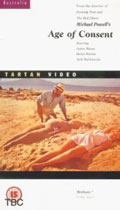
Directed by
Michael Powell
105 minutes
Rated M
Reviewed by
Bernard Hemingway

Age Of Consent
From a post-colonial point of view it is unfortunate that two British actors (James Mason, who co-produced, and Helen Mirren) were imported to play the leads as a couple of Australians in this rendition of the Norman Lindsay novel but it is, nevertheless, an enjoyable film.
Powell, effectively in self-imposed exile from his beloved mother country after the scathing response to Peeping Tom (1960) and having already made They're A Weird Mob (1966), by all accounts did not think much of his source material or the outcome, reserving most of his praise for it in his memoirs to the dog's admittedly engaging performance.
A kind of feral comedy of manners set on a tropical island (Dunk Island in actuality) it follows the fortunes of a worn-out painter (Mason) who travels back to his native Australia to re-kindle his artistic fire. The urbane Mason is, as always is very watchable, although his attempt to simulate an Australian accent more often than not seems more parodic than anything else. Helen Mirren, in a performance that in Powell's hands recalls that of Jennifer Jones in Powell and Pressburger's 1950 film, Gone To Earth, at 23 is too old for the part but she enters into the spirit of it with remarkable enthusiasm, spending significant portions of it naked, which, no doubt would have been quite titillating for its time. The support cast including Jack MacGowran, Neva Carr-Glyn, Harold Hopkins, Michael Boddy and Frank Thring all help to make this an entertaining romp, although Mason and Mirren make it much more than just a comedy, the film also standing quite well as a romantic portrait of bohemian artist life.
Apparently the paintings done by Mason's character whilst on the island were actually painted by Paul Delprat, although the tapestries that appear at the start of the film were by John Coburn. There is no mention of the apparent stylistic dissonance, so either no-one cared enough to explain it or the shift from abstraction to figuration was meant to be understood as part of the painter's re-awakening. The pellucid colour throughout the film was achieved by duplicating the original Technicolor method of a three reel tint (CMY) on black and white stock then matching all three to create a color negative (the Coburn paintings in the gallery sequence look stunning and in one of them a blue section appears to hover over the canvas). The original score was by Peter Sculthorpe, although for its British and US release Columbia replaced this and cut 10 mins from the film. This was Powell's last film although he lived until 1990.
Want something different?





